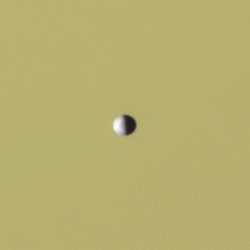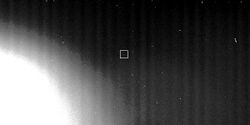Astronomy:Pallene (moon)
 Cassini image of Pallene transiting Saturn on October 16, 2010 | |
| Discovery | |
|---|---|
| Discovered by | Voyager 2 (first discovery) Cassini Imaging Team[1] |
| Discovery date | June 1, 2004 (second discovery by Cassini-Huygens) |
| Designations | |
Designation | Saturn XXXIII |
| Pronunciation | /pəˈliːniː/[2] |
| Named after | Παλλήνη Pallēnē |
| S/1981 S 14 (first discovery) S/2004 S 2 (second discovery) | |
| Adjectives | Pallenean /pælɪˈniːən/[3] |
| Orbital characteristics [5] | |
| Epoch 20 June 2004 (JD 2453177.5) | |
| 212300 km[4] | |
| Eccentricity | 0.004[4] |
| Orbital period | 1.009549 d[4] |
| Inclination | 0.1810°±0.0014° (to Saturn's equator) |
| Satellite of | Saturn |
| Group | Alkyonides |
| Physical characteristics | |
| Dimensions | 5.76 × 4.16 × 3.68 km (± 0.14 × 0.14 × 0.14 km)[6](p2) |
| Mean diameter | 4.46±0.14 km[6](p2) |
| Volume | 46.5 km3[lower-alpha 1] |
| Mass | (1.15±0.40)×1013 kg[6](p3) |
| Mean density | 0.251±0.075 g/cm3[6](p3) |
| 0.011–0.016 mm/s2[6](p3) | |
| 0.0007 km/s at longest axis to 0.0009 km/s at poles | |
| Rotation period | synchronous |
| Axial tilt | zero |
Pallene /pəˈliːniː/ is a very small natural satellite of Saturn. It is one of three small moons known as the Alkyonides that lie between the orbits of the larger Mimas and Enceladus. It is also designated Saturn XXXIII.
Discovery

Pallene was discovered by the Cassini Imaging Team in 2004, during the Cassini–Huygens mission.[7][8] It was given the temporary designation S/2004 S 2. In 2005, the name Pallene was provisionally approved by the IAU Division III Working Group for Planetary System Nomenclature,[9] and was ratified at the IAU General Assembly in 2006. The name refers to Pallene, one of the Alkyonides, the seven beautiful daughters of the giant Alkyoneus.
After the discovery in 2004, it was realized that Pallene had been first photographed on August 23, 1981, by the space probe Voyager 2. It had appeared in a single photograph and had been provisionally named S/1981 S 14 and estimated to orbit 200,000 km from Saturn.[10] Because it had not been visible in other images, it had not been possible to compute its orbit at the time, but recent comparisons have shown it to match Pallene's orbit.[5]
Orbital characteristics
Pallene is visibly affected by a perturbing mean-longitude resonance with the much larger Enceladus, although this effect is not as large as Mimas's perturbations on Methone. The perturbations cause Pallene's osculating orbital elements to vary with an amplitude of about 4 km in semi-major axis, and 0.02° in longitude (corresponding to about 75 km). Eccentricity also changes on various timescales between 0.002 and 0.006, and inclination between about 0.178° and 0.184°.[5]
Ring
In 2006, images taken in forward-scattered light by the Cassini spacecraft enabled the Cassini Imaging Team to discover a faint dust ring around Saturn that shares Pallene's orbit, now named the Pallene Ring.[11][12] The ring has a radial extent of about 2,500 km. Its source is particles blasted off Pallene's surface by meteoroid impacts, which then form a diffuse ring around its orbital path.[13][14]
Exploration
The Cassini spacecraft, which studied Saturn and its moons until September, 2017, performed a fly-by of Pallene on 16 October 2010, and 14 September 2011 at a distance of 36,000 kilometers (22,000 miles) and 44,000 kilometers respectively.[15]
Notes
References
Citations
- ↑ Cassini Imaging Team.
- ↑ Noah Webster (1884) A Practical Dictionary of the English Language
- ↑ "JPL (ca. 2008) Cassini Equinox Mission: Pallene". http://saturn.jpl.nasa.gov/science/moons/pallene/.
- ↑ 4.0 4.1 4.2 "Planetary Satellite Mean Orbital Parameters". Jet Propulsion Laboratory. https://ssd.jpl.nasa.gov/sats/elem/sep.html.
- ↑ 5.0 5.1 5.2 Spitale Jacobson et al. 2006.
- ↑ 6.0 6.1 6.2 6.3 6.4 6.5 Thomas & Helfenstein 2020.
- ↑ IAUC 8389.
- ↑ Porco Baker et al. 2005.
- ↑ IAUC 8471.
- ↑ IAUC 6162.
- ↑ IAUC 8759.
- ↑ CICLOPS 2006, Moonmade Rings.
- ↑ JPL/NASA: Creating New Rings.
- ↑ Hedman et al., 2009.
- ↑ "Cassini Tour Event Summary – Planned Observations of Small Satellites". Planetary Atmospheres Node. Planetary Data Services. https://atmos.nmsu.edu/data_and_services/atmospheres_data/Cassini_PDS3/logs/small%20satellites_Events_as_planned.txt. Retrieved 31 March 2022.
Sources
- "Cassini Imaging Science Team". Cassini Imaging Central Laboratory for OPerationS. http://ciclops.org/team/iss_team.php.
- "Moonmade Rings". Cassini Imaging Central Laboratory for OPerationS. October 11, 2006. http://ciclops.org/view.php?id=2276.
- Green, Daniel W. E. (April 14, 1995). "Possible Satellites of Saturn". IAU Circular 6162. http://www.cbat.eps.harvard.edu/iauc/06100/06162.html. Retrieved 2012-01-01.
- Green, Daniel W. E. (August 16, 2004). "S/2004 S 1 and S/2004 S 2" (discovery). IAU Circular 8389: 1. Bibcode: 2004IAUC.8389....1P. http://www.cbat.eps.harvard.edu/iauc/08300/08389.html. Retrieved 2012-01-01.
- Green, Daniel W. E. (January 21, 2005). "S/2004 S 1 and S/2004 S 2" (naming the moon). IAU Circular 8471. http://www.cbat.eps.harvard.edu/iauc/08400/08471.html. Retrieved 2012-01-01.
- Green, Daniel W. E. (October 11, 2006). "Rings of Saturn (R/2006 S 1, R/2006 S 2, R/2006 S 3, R/2006 S 4)". IAU Circular 8759: 1. Bibcode: 2006IAUC.8759....1P. http://www.cbat.eps.harvard.edu/iauc/08700/08759.html. Retrieved 2012-01-01.
- Hedman, M. M.; Murray, C. D.; Cooper, N. J.; Tiscareno, M. S.; Beurle, K.; Evans, M. W.; Burns, J. A. (2008-11-25). "Three tenuous rings/arcs for three tiny moons". Icarus 199 (2): 378–386. doi:10.1016/j.icarus.2008.11.001. ISSN 0019-1035. Bibcode: 2009Icar..199..378H.
- "NASA Finds Saturn's Moons May Be Creating New Rings". Cassini Solstice Mission. JPL/NASA. October 11, 2006. http://saturn.jpl.nasa.gov/news/newsreleases/newsrelease20061011-3/.
- Porco, C. C.; Baker, E.; Barbara, J.; Beurle, K.; Brahic, A.; Burns, J. A.; Charnoz, S.; Cooper, N. et al. (February 25, 2005). "Cassini Imaging Science: Initial Results on Saturn's Rings and Small Satellites". Science 307 (5713): 1226–1236. doi:10.1126/science.1108056. PMID 15731439. Bibcode: 2005Sci...307.1226P.
- Spitale, J. N.; Jacobson, R. A.; Porco, C. C.; Owen, W. M. Jr. (2006). "The orbits of Saturn's small satellites derived from combined historic and Cassini imaging observations". The Astronomical Journal 132 (2): 692–710. doi:10.1086/505206. Bibcode: 2006AJ....132..692S.
- Thomas, P. C. (July 2010). "Sizes, shapes, and derived properties of the saturnian satellites after the Cassini nominal mission". Icarus 208 (1): 395–401. doi:10.1016/j.icarus.2010.01.025. Bibcode: 2010Icar..208..395T. http://www.ciclops.org/media/sp/2011/6794_16344_0.pdf. Retrieved 2015-09-04.
- Thomas, P. C.; Burns, J. A.; Tiscareno, M. S.; Hedman, M. M.; Helfenstein, P. (2013). "Saturn's Mysterious Arc-Embedded Moons: Recycled Fluff?". pp. 1598. http://www.lpi.usra.edu/meetings/lpsc2013/pdf/1598.pdf. Retrieved 2013-05-21.
- Thomas, P. C.; Helfenstein, P. (July 2020). "The small inner satellites of Saturn: Shapes, structures and some implications". Icarus 344: 20. doi:10.1016/j.icarus.2019.06.016. 113355. Bibcode: 2020Icar..34413355T.
External links
 |




